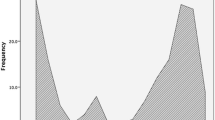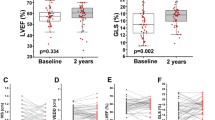Abstract
The clinical course of acute myocarditis (AM) in children varies from being asymptomatic to causing sudden cardiac death. The aim of this study was to clarify the clinical characteristics and the long-term outcome of AM in children. We enrolled 24 children (aged from 0.1 to 14.6 years, median 8.4 years), who were diagnosed as AM between 1978 and 2010. The maximum follow-up period was 31 years (median 7 years). We retrospectively investigated their clinical course of AM. We also analyzed survival rate, persistence of decreased left ventricular ejection fraction (LVEF) by two-dimensional echocardiogram (2DE), and persistence of complete atrioventricular block (CAVB) by the Kaplan–Meier method. Furthermore, using univariate analysis we analyzed the factors that influenced the outcome. The survival rate was 86 % (95 % confidence interval (CI), 65–96) at 30 years. The persistence rate of LVEF less than 60 % at 1 month, 1 years, and 3 years was 44 % (95 % CI, 22–68), 36 % (95 % CI, 17–62) and 18 % (95 % CI, 3–59), respectively (n = 16), and the persistence of CAVB at 10 days was 36 % (95 % CI, 14–66, n = 11). In six patients with persistence of wide QRS (>100 ms), there were one acute death, two late deaths, and one orthotopic heart transplantation. The 30-year survival rate for six patients with wide QRS and 17 patients without wide QRS in the late phase was 50 % (95 % CI, 17–83) and 100 % (P = 0.0078), respectively. The factors in the acute phase influenced on the outcome were log creatine phosphokinase (CPK) 4.60 (95 % CI, 1.64–29.26, P = 0.001), appearance of ventricular tachycardia 19.71 (95 % CI, 2.50–399.9, P = 0.005), and LVEF 0.91 (95 % CI, 0.81–0.98, P = 0.015), respectively. The predictors of poor outcome in children with AM were high serum CPK, appearance of ventricular tachycardia and low LVEF in the acute phase, and persistence of wide QRS in the late phase. The long-term survival rate of children without these factors was fair.




Similar content being viewed by others
References
Aretz HT, Billingham ME, Edwards WD, Factor SM, Fallon JT, Fenoglio JJ Jr, Olsen EG, Schoen FJ (1987) Myocarditis. A histopathologic definition and classification. Am J Cardiovasc Pathol 1:3–14
Cooper LT Jr (2009) Myocarditis. N Engl J Med 360: 1526–1538
Amabile N, Fraisse A, Bouvenot J, Chetaille P, Ovaert C (2006) Outcome of acute fulminant myocarditis in children. Heart 92:1269–1273
Kotilainen P, Lehtopolku M, Hakanen A (2006) Myopericarditis in a patient with Campylobacter enteritis: a case report and literature review. Scand J Infect Dis 38:549–552
Kindermann I, Kindermann M, Kandolf R, Klingel K (2008) Predictors of outcome in patients with suspected myocarditis. Circulation 118:e493
Nishii M, Inomata T, Takahana H, Takeuchi I, Nakano H, Koitabashi T, Nakahata J, Aoyama N, Izumi T (2004) Serum levels of interleukin-10 on admission as a prognostic predictor of human fulminant myocarditis. J Am Coll Cardiol 44:1292–1297
Ukena C, Mahfoud F, Kindermann I, Kanadolf R, Kindermann M (2011) Prognostic electrocardiographic parameters in patients with suspected myocarditis. Eur J Heart Fail 13:398–405
Morgera T, Lenarda A, Dreas L, Pinamonti B, Humar F, Bussani R, Silvestri F, Chersevani D, Camerini F (1992) Electrocardiography of myocarditis revisited: clinical and prognostic significance of electrocardiographic changes. Am Heart J 124:455–467
Nakashima H, Katayama T, Ishizaki M, Takeno M, Honda Y, Yano K (1998) Q wave and non-Q wave myocarditis with special reference to clinical significance. Jpn Heart J 39:763–774
Towbin JA, Bricker JT, Garson A Jr (1992) Electrocardiographic criteria for diagnosis of acute myocardial infarction in childhood. Am J Cardiol 69:1545–1548
Chien SJ, Liang CD, Lin YJ, Huang CF (2008) Myocarditis complicated by complete atrioventricular block: nine years’ experience in a medical center. Pediatr Neonatal 49:218–222
Pinamonti B, Alberti E, Cigalotto A, Dreas L, Salvi A, Silvestri F, Camerini F (1988) Echocardiographic findings in myocarditis. Am J Cardiol 62:285–291
Aretz HT (1987) Myocarditis: the Dallas criteria. Hum Pathol 18:619–624
Baughman KL (2006) Diagnosis of myocarditis. Death of Dallas criteria. Circulation 113: 593–595
Batra AS, Epstein D, Silka MJ (2003) The clinical course of acquired complete heart block in children with acute myocarditis. Pediatr Cardiol 24:495–497
Wang JN, Tsai YC, Lee WL, Lin CS, Wu JM (2002) Complete atrioventricular block following myocarditis in children. Pediatr Cardiol 23:518–521
Acknowledgments
We thank Professor Peter Olley for his kind English language consultation.
Author information
Authors and Affiliations
Corresponding author
Rights and permissions
About this article
Cite this article
Abe, T., Tsuda, E., Miyazaki, A. et al. Clinical characteristics and long-term outcome of acute myocarditis in children. Heart Vessels 28, 632–638 (2013). https://doi.org/10.1007/s00380-012-0296-8
Received:
Accepted:
Published:
Issue Date:
DOI: https://doi.org/10.1007/s00380-012-0296-8




